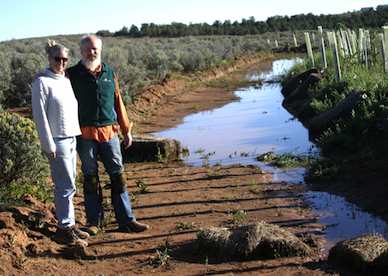
Grant and Kathy Curry of Dolores are creating an innovative farm at the head of Trail Canyon in Dolores, Colorado that they hope will produce food for generations while skimping on water.
“I want to enter the garden and bump my head on hanging fruit, to have raspberries and nuts at my feet and vegetables that come up every year on their own,” says Grant Curry, a slim, knowledgeable man in his 50s. When not farming, he works as registered nurse in Chinle, Arizona.
The Currys are committed to holistic practices and a back-to-the-garden lifestyle. Their solar-powered home is off the grid, they catch rain (with a permit), have greenhouses, raise their food and host agricultural programs at their 80-acre Hananiah’s Rest Ranch.
Grant recently became a certified permaculture designer. He plans to help area families foster more efficient gardening.
Permaculture farming groups grow crops in a complementary way using natural ecosystems. They are designed to regenerate year to year.
This summer, with occasional help from their grown children, the Currys installed a twisting 3,800-foot swale and 2,000-foot berm structure, then planted 600 trees and shrubs on it.
What does the berm do?
“We get asked a lot,” Kathy says. “You have to see it to believe it.”
The climate of the Southwest is known for its low annual rainfall, which seems to either never come or to come all at once.
Kathy explained the serpentine berm-swale system catches the water, slows it down and allows it to soak in. Over time, a plume of moist earth gets bigger and bigger, an ideal environment for growing food.
“The berm acts like a sponge, drawing up the water to the food forest,” Grant said. “Under the trees, we’re planting vegetables, nuts, berries – everything will be food, enough to feed 100 people.”
The trees eventually create a microclimate, creating shade and dew, which also moisten the soil. Permaculture farming can bump up the usual 12 inches of precipitation per year to the equivalent of 18 inches per year, Grant said.
“The Navajo Nation is very dry with limited precipitation; I feel more families can benefit from this,” he said. “It’s a great opportunity for food security.”
The couple’s enthusiasm has caught the attention of the Colorado Permaculture Convergence, which will hold its 2015 conference on the farm May 23.
For two days, the public can learn about sustainable farming practices, listen to speakers, and attend workshops.
For more information visit Grant and Kathy Curry’s Facebook page at www.facebook.com/PermacultureProvisionProject